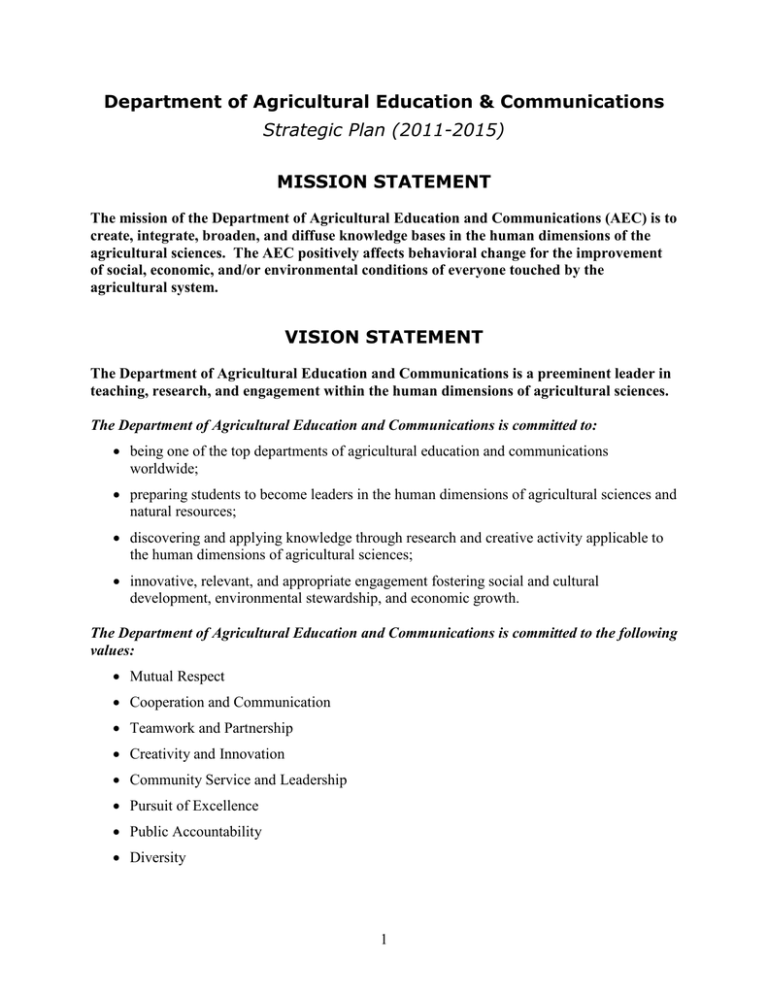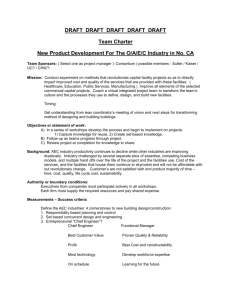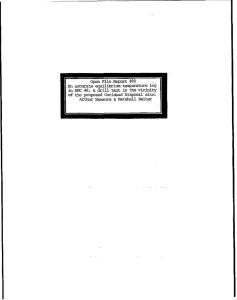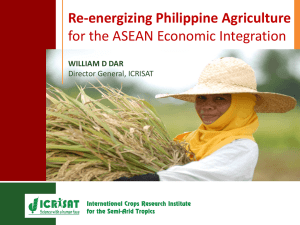Department of Agricultural Education & Communications MISSION STATEMENT Strategic Plan (2011-2015)
advertisement

Department of Agricultural Education & Communications Strategic Plan (2011-2015) MISSION STATEMENT The mission of the Department of Agricultural Education and Communications (AEC) is to create, integrate, broaden, and diffuse knowledge bases in the human dimensions of the agricultural sciences. The AEC positively affects behavioral change for the improvement of social, economic, and/or environmental conditions of everyone touched by the agricultural system. VISION STATEMENT The Department of Agricultural Education and Communications is a preeminent leader in teaching, research, and engagement within the human dimensions of agricultural sciences. The Department of Agricultural Education and Communications is committed to: • being one of the top departments of agricultural education and communications worldwide; • preparing students to become leaders in the human dimensions of agricultural sciences and natural resources; • discovering and applying knowledge through research and creative activity applicable to the human dimensions of agricultural sciences; • innovative, relevant, and appropriate engagement fostering social and cultural development, environmental stewardship, and economic growth. The Department of Agricultural Education and Communications is committed to the following values: • Mutual Respect • Cooperation and Communication • Teamwork and Partnership • Creativity and Innovation • Community Service and Leadership • Pursuit of Excellence • Public Accountability • Diversity 1 OUTCOMES, ASSESSMENT METHODS, OBJECTIVES AND STRATEGIES Outcome 1: Increase Enrollment and Promote Student Success KEY OUTCOME: The AEC will grow and diversify our student population in order to improve higher education participation and prepare a well-equipped, educated workforce. Assessment Methods: • Enrollment of 34 additional undergraduates. (2010: 241; 2015 Outcome: 275) • Enrollment of 29 additional graduate students. (2010: 59; 2015 Outcome: 88) • 50% of the first-time entering freshman class students at the institution are in the top 25% of their high school class (as measured by Mean Class Rank of entering freshmen) • Mean SAT score of 1200 for first-time entering freshman class students • Mean ACT score of 26 for first-time entering freshman class students • Achieve 10% ethnic diversity of entering freshman. • 80% first year undergraduate retention rate. (2010: 75%; 2015 Outcome: 80%) • 80% second year retention rate for majors or degree seekers. • 60% 4-year undergraduate graduation rate. (2010: 60%; 2015 Outcome: 60%) • 70% 6-year undergraduate graduation rates in the major or degree program • 100 students enrolled in courses at distance per year. (2010: 60; 2015 Goal: 100) • Offer 5 undergraduate courses at distance. (2010: 1; Goal for 2015: 5) • Complete conversion of resident Ed.D. program to a Ph.D. program • Offer 3 graduate degree programs through distance learning. (2010: 2; Goal for 2015: 3) • Offer 20 graduate courses through distance learning. (2010: 10; Goal for 2015: 44) • Offer 2 certificate programs for professional development and continuing education. (2010: 0; 2015 Outcome:2) • 60 undergraduates involved in formal internships per year. (2010: 45; 2015 Goal: 60) • 15 undergraduates involved in study abroad and international experience per year.(2010: 5; 2015 Goal: 15) • 10 undergraduates involved in research per year. • Mean GRE score of 875 for entering Masters students. • Mean GRE score of 1050 entering Doctoral students. • 80% Master’s graduation rate. • 90% Doctoral graduation rate. • Median time to Doctoral degree completion of 3.5 years. • 70 undergraduate degrees awarded per year. (2010: 75; 2015 Goal 70) • 15 Master degrees awarded per year. • 5 Doctoral degrees awarded per year. 2 Objectives: Objective 1.1: Increase student numbers and diversity Strategies: • Strengthen recruiting efforts targeting traditional and non-traditional AEC markets. • Enhance recruiting efforts and collaborative programs targeting four-year colleges, community colleges, and science and advanced placement classes at selected high schools. • Strengthen recruiting efforts to attract high-quality graduate students from selected liberal arts colleges and prestigious research universities across the globe. • Increase recruiting efforts in areas with high minority student populations. • Increase overall scholarship funds, and focus on scholarships targeted at minority students. Objective 1.2: • • Strategies: Use scholarships that target high-achievements students. Emphasize STEM and pre-professional options for undergraduates. Objective 1.3: • • • Increase recruitment of high achievement students into freshman class Increase distance learning opportunities Strategies: Provide technical and financial assistance for distance learning. Increase number of distance-based courses and degree programs. Partner with other universities (e.g., Ag IDEA) in providing distance-based degrees. Objective 1.4: Provide undergraduate, graduate, and professional curricula and programs that enhance disciplinary knowledge and analytical, creative thinking, and leadership skills Strategies: • Conduct comprehensive curriculum reviews to assess the capacity of current programs and needs for change. • Incorporate input from AEC Advisory Committee members in evaluation of curriculum. Objective 1.5: Increase participation in study abroad, exchange programs, and involvement in research Strategies: • Devote special effort in developing study abroad and exchange programs. • Provide special problem and internship opportunities for undergraduate students involved in research. Objective 1.6: Increase the number of high-quality graduate level programs Strategies: • Increase scholarships and fellowships for graduate students. • Provide scholarships that will cover the cost of all tuition and fees for graduate students. 3 • Provide funding for recruitment of high-quality graduate students. Outcome 2: Enhance Academic Quality and Reputation KEY OUTCOME: Attain national recognition in undergraduate, graduate, and professional education and increase national and international stature and recognition of faculty, staff, and students. Assessment Methods: • 1 traditional and 1 targeted faculty hire by 2015. • 100% staff involved in professional development activities per year. • .25 staff awards per year. • 1 tenured/tenure-track faculty who have achieved professional recognition as a fellow of a national society by 2015. • 5 tenured/tenure-track faculty holding officer/board positions in professional societies by 2015. • 11 tenured/tenure-track faculty serving on special Federal/State/Regional committees/boards/review panels by 2015. • 5 state, regional, and national championships for AEC collegiate teams and clubs by 2015. • 2 endowed chairs and professorships by 2015. (2010: 1; 2015 Outcome: 2) • 1 formal student exchange program with an international institution by 2015. Objectives: Objective 2.1: Recruit, mentor, retain, recognize, and reward outstanding, diverse faculty and staff Strategies: • Leverage targeted hiring opportunities provided by the Office of the Vice President for Research. • Hire new faculty in areas that have been identified as strategic opportunities in research and teaching. • Ensure consistent efforts to mentor young faculty. • Facilitate and encourage faculty participation in professional development opportunities. • Facilitate and encourage staff participation in professional development opportunities. Objective 2.2: Increase national recognition of faculty and students Strategies: • Have a mechanism to consistently evaluate and nominate faculty for university and professional awards and honors. • Charge the AEC Scholarship & Awards Committee with annually evaluating students for nomination to university, regional, and national awards. 4 Objectives 2.3: Develop a formal exchange programs with an international institution. Strategies • Evaluate other exchange programs to determine return on investment. • Examine opportunities for a new exchange programs in the context of how it will complement AEC teaching and research efforts. Outcome 3: Expand and Enhance Research and Creative Scholarship KEY OUTCOME: Increase the amount of research dollars available in order to increase national recognition in research and creative scholarship. Assessment Methods: • 10 undergraduates involved in research per year. (2010: 5; 2015 Goal: 10) • 5 multi-department, college, and institutional research proposals submitted per year • 2.5 multi-department, college, and institutional research proposals funded per year • 20 refereed journal publications per year. • 10 research proposals submitted per year. • $2.5 million worth of research proposals submitted per year. • $450,000 restricted research expenditures (2010: $254 K; 2015 Outcome: $450 K) • $1.2 million total research funding per year. (2010: $.72 M; 2015 Outcome: $1.2 M) • 100% faculty generating sponsored research funding per year. (2010: 70%; 2015 Outcome: 100%) Objectives: Objective 3.1: Enhance existing research programs and develop new research initiatives Strategies: • Establish a prioritized list of areas of research excellence in the Human Dimension of Agricultural Sciences. • Provide opportunities to promote research in the areas of research excellence. Objective 3.2: Promote and support collaborative research Strategies: • Secure and provide funding to promote collaborative and multidisciplinary research opportunities. • Develop methods to reward PIs and Co-PIs involved in collaborative research. Objective 3.3: Foster research programs that contribute to local and regional economic development and entrepreneurship Strategies: • Use the AEC advisory committee and interactions with other industry groups to establish priorities for research. 5 Objective 3.4: Increase research funding Strategies: • Provide incentives (release time, graduate student support, post doctoral support, etc.) to faculty who obtain significant competitive grant funding. • Facilitate efforts to secure more research funding from international funding agencies, corporations and foundations. Outcome 4: Strengthen Outreach and Engagement KEY OUTCOME: Increase outreach and engagement activities and public knowledge and support of AEC. Assessment Methods: • 35 workshops, symposia, and other events per year sponsored or supported for governmental agencies, non-governmental organizations, producers, industry groups, trade associations, and consumers. (2010: 30; 2015 Outcome: 35) • Re-establish 1 joint appointment between AEC and the Texas AgriLife Extension. (2010: 1; 2015 Outcome: 1) • Offer 5 courses with service learning component per year. (2010: 3; 2015 Outcome: 5) • 15 newscasts per year on local, regional, or national print news, radio and television media. • 2 alumni functions per year. (2010: 1; 2015 Outcome: 2) • Presence in social networks such as Facebook, blogs, etc. • Publication of the Agriculturalist on the Web. • Continuation of annual alumni reception, 4-H activities, and FFA activities. Objectives: Objective 4.1: Strengthen partnerships and collaborations with all groups involved in education and research in agriculture and natural resources. Strategies: • Increase cooperative efforts with TAMU AgriLife Research and Extension and USDAARS. • Increase cooperative efforts with state livestock shows (HLSR, SALE, Star of Texas, etc.) whose mission is education in agriculture. Objective 4.2: Strengthen and initiate partnerships and cooperation within the Texas Tech University System and with other institutions. Strategies: • Enhance partnerships and cooperation with other units of the Texas Tech University System. 6 • Expand partnerships to other universities in the region (e.g., Angelo State University, West Texas A&M University, and Eastern New Mexico University). Objective 4.3: Increase faculty, staff, and student involvement in service learning and outreach activities. Strategies: • Increase service-learning opportunities in AEC courses by developing additional courses with service learning component. Objective 4.4: Enhance public awareness of AEC Strategies: • Increase articles in local and regional newspapers and on the Web about high-visibility AEC research and teaching. Objective 4.5: Inform alumni of departmental accomplishments and encourage them to be ambassadors for the AEC Strategies: • Develop social media-based applications for alumni that will share AEC news and information. Outcome 5: Increase and Maximize Resources KEY OUTCOME: Increase funding and optimize resource allocation for scholarships, professorships, endowments, and facilities while enhancing our stewardship of those resources. Assessment Methods: • Balanced unrestricted direct revenues and expenditures. • 8000 total weighted student credit hours per year. • $120K scholarship support for AEC students per year. (2010: $80K; 2015 Outcome: $120K) • 50% undergraduate and graduate students on scholarship per year. (2010: 35%; 2015 Outcome: 50%) • $2.5M total endowments by 2015. (2010: $1.8M; 2015 Outcome: $2.5M) • $100K value of cash donations per year. (2010: $50K; 2015 Outcome: $100K) Objectives: Objective 5.1: Develop and integrate a new budget model (that tracks unrestricted revenues and expenditures) into AEC decision-making process to maximize fiscal performance. Strategies: • Apply approaches for development of teaching and research priorities for AEC. 7 Objective 5.2: Raise more money for scholarship endowments Strategies: • Increase coordinated efforts alumni, the CASNR Development Office and agricultural organizations to obtain endowed scholarships. Objective 5.3: Raise more money for faculty professorships and endowments Strategies: • Increase coordinated efforts between AEC, CASNR Dean’s Office, and CASNR Development Office to obtain endowed chairs and professorships, particularly from nontraditional sources. Outcome 6: Advance the Center for Agricultural Technology Transfer KEY OUTCOME: Enhance the transfer of agricultural information to agricultural and non-agricultural audiences through education and the development of instructional media competencies. Assessment Methods: • At least 15 newscasts per year on local, regional, and national print news, radio and television media and publication of the Agriculturist on the Web and paper copy. (20010: 12; 2015 Outcome: 15) • Increase the technological competence of TTU graduates, especially students in agricultural communications. (2010: 15% of CATT endowment dedicated towards technology enhancement of academic programs; 2015 Outcome: 20% of CATT endowment dedicated towards technology enhancement of academic programs) • Enhance technological competence of individuals not enrolled in TTU to enhance their technological competencies. (2010: 100 producers participate in workshops: 2015 Outcome: 200 producers Objectives: Objective 6.1: Facilitate the dissemination of agricultural information and technologies to appropriate audiences. Strategies: • Strengthen ties with TTU Marketing and Communications and CASNR Marketing and Communications to promote programs. • Develop alternative social media outlets for the marketing and promotion of AEC. Objective 6.2: Increase the technological competence of TTU graduates, especially students in agricultural communications. Strategies: 8 • Maintain state-of-the-art video editing and desktop publishing laboratories. • Closely interface with industry leaders in agricultural communications. • Expand student internship opportunities to include the Star of Texas Rodeo and the Houston Livestock Show and Rodeo. Objective 6.3: Enhance technological competence of individuals not enrolled in TTU to improve their technological competencies. Strategies: • Continue workshops, farmer field schools, and field days for producers. • Continue to offer workshops for professionals working directly with producers of youth who aspire to farm, ranch or enter careers in natural resources management. Objective 6.4: Improve university access to place-bound Texans. Strategies: • Admit cohorts of Doc @ Distance on a bi-annual basis. • Receive approval and launch distance program in Agricultural teacher certification. 9



